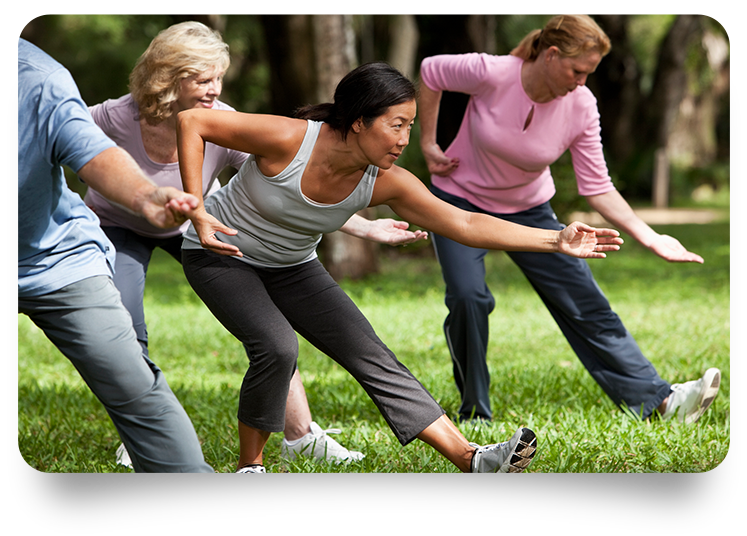Treatments
tai chi and qigong
WHAT IS IT?
Tai Chi
Tai chi is an ancient Chinese tradition first developed for self-defense. It is practiced as a graceful form of exercise. It involves focused slow movements with deep breathing. There are many styles and forms of tai chi. The major forms are Chen, Yang, Wu, Wu (different words in Chinese) and Sun. Each style has its own features. All styles share the same basic principles.
The principles of tai chi include mind integrated with the body; control of movements and breathing; bringing internal energy, mindfulness, song (loosening 松) and jing (serenity 静). The purpose of tai chi is to cultivate the qi or life energy within us to flow smoothly and powerfully through the body. Total harmony of the inner and outer self comes from the integration of mind and body, empowered through healthy qi through the practice of tai chi.
Tai chi is used for stress reduction and a variety of other health conditions. Often described as meditation in motion, tai chi promotes serenity through gentle, flowing movements.
Qigong
Although tai chi and qigong come from the same roots, and qigong is not a considered a martial art. The qigong movements are less orchestrated than tai chi, and tend to be simpler. Its origins go back over 4,000 year in Chinese culture and over the years many different forms have developed. It is used in traditional Chinese medicine as a preventive and curative practice. There is also a Daoist meditative practice of qigong. During the 40’s and 50’s the Chinese government tried to standardized these practices and more recently the government has encourage daily morning practice of qigong.
Qigong may include:
- Dynamic, choreographed, flowing movements that including breath and awareness
- Static practices that where postures are held
- Meditative practices that use rhythmic breathing, visualization, chanting and other focusing techniques
- Addition of herbs, massage and physical manipulation
OUR BOTTOM LINE: DOES IT HELP?
DON’T KNOW. At this time there is not enough research to say if tai chi or qigong will help improve any menopause symptoms. According to Chinese tradition, both activities may help stave off aches and pains related to aging, but high quality research is needed. Although some studies suggest that tai chi and qigong can help with depression, the research quality is poor, so we think you are better off with trying other interventions. Studies on tai chi and qigong have not addressed depression and aches and pains menopause specifically.
RISKS AND SIDE EFFECTS
Neither activity is considered risky. Both are considered forms of “movement therapy.” Research is examining using them with patients with a wide variety of diseases, including Parkinson’s, cancer, and diabetes. Tai chi is used to increase balance and prevent falls in older adults.
Huang Z, Feng Y, Li Y, et al. Systematic review and meta-analysis: Tai Chi for preventing falls in older adults. BMJ Open 2017;7:e013661. doi: 10.1136/bmjopen-2016-013661
Liu X, Clark J, Siskind D, Williams GM, Byrne G, Yang JL, Doi SA. A systematic review and meta-analysis of the effects of Qigong and Tai Chi for depressive symptoms. Complement Ther Med. 2015 Aug;23(4):516-34. doi: 10.1016/j.ctim.2015.05.001. Epub 2015 May 27. PMID: 26275645.
Marks R. Qigong and Musculoskeletal Pain. Curr Rheumatol Rep. 2019 Nov 16;21(11):59. doi: 10.1007/s11926-019-0861-6. PMID: 31734867.
So WWY, Cai S, Yau SY, Tsang HWH. The Neurophysiological and Psychological Mechanisms of Qigong as a Treatment for Depression: A Systematic Review and Meta-Analysis. Front Psychiatry. 2019 Nov 18;10:820. doi: 10.3389/fpsyt.2019.00820. PMID: 31824346; PMCID: PMC6880657.
Authors: Dr. Katherine Newton & Dr. Leslie Snyder. Last reviewed April 29, 2021.



